Catalonia’s new tax on 15,000 empty flats owned by banks as “incentive” to have them rented
The Catalan Minister for Territory and Sustainability, Santi Vila, who is also in charge of housing policies, presented on Tuesday the draft of a new tax bill on empty flats and houses owned by financial institutions in Catalonia. During a press conference, Vila explained that such a tax is looking to be an “incentive” for banks to make available their 15,000 flats spread across 70 municipalities with “proven demand” for housing, mainly around Barcelona, Tarragona, Lleida and Girona, and which have been empty for more than 2 years without a justified cause. The amount of the tax will be based on the total number of square meters owned by the banks and will include significant accumulative bonuses if the institutions decide to rent their properties, notably for social housing. The Catalan Government estimates that banks own around 40,000 empty flats, including in areas with housing demand.

Barcelona (ACN).- The Catalan Minister for Territory and Sustainability, Santi Vila, who is also in charge of housing policies, presented on Tuesday the draft of a new tax bill on empty flats and houses owned by financial institutions in Catalonia. During a press conference, Vila explained that such a tax is looking to be an “incentive” for banks to make available their 15,000 flats spread across 70 municipalities with “proven demand” for housing, mainly around Barcelona, Tarragona, Lleida and Girona, and which have been empty for more than 2 years without a justified cause. The amount of the tax will be based on the total number of square meters owned by the banks and will include significant accumulative bonuses if the institutions decide to rent their properties, notably for social housing. The Catalan Government estimates that banks own around 40,000 empty flats, including in areas with housing demand. The tax was part of the parliamentary stability agreement signed in December 2012 between the governing Centre-Right Catalan Nationalist Coalition (CiU) and the Left-Wing Catalan Independence Party (ERC). Furthermore, last April, Vila announced the tax was being studied.
The amount of the new tax will be calculated according to the combined surface of flats and houses owned by financial institutions in areas with high demand, divided into three categories. If the surface of vacant homes reaches up to 10,000 m2, the tax will be equivalent to between €3 and €6 per m2. Between 10,000 m2 and 50,000 m2, it will be set at between €7 and €10 per m2. And from 50,000 m2 onwards, it will reach between €11 and €20 per m2. It is expected that for each flat, the tax will amount to between €850 and €1,650 per year.
Santi Vila said that the new tax would include bonuses, which prove that the Catalan Government has “no intention of collecting money” but wants the tax to act as an “incentive” for banks to rent their empty properties. “It’s an ambitious tax, but it will come with bonuses if financial institutions do what the Government is wishing for”, he explained.
Up to 75% of discount for the institutions renting part of their property
Thus, if the financial institution decides to rent between 5% and 10% of its flats, it will get a 10% discount. If it makes between 10% and 25% of its housing available, it will benefit from a 30% discount. Between 25% and 40%, such a discount will reach 50%, and if the bank rents over 40% of its surface, the discount will amount to 75%.
Aiming to double the number of social housing in Catalonia with existing flats
“Housing is a basic need and has a social function” stated Vila, who explained that the Catalan Executive was looking to honour the right to decent and affordable housing.
While the Government estimates that banks and real estate companies own a total of 40,000 vacant flats and houses in Catalonia, the tax is only aimed at the 15,000 empty homes spread over 70 municipalities with proven demand, mainly in the metropolitan areas of Barcelona and Tarragona, as well as in the areas around Girona and Lleida. If these 15,000 flats were made available to rent, it would double the number of social housing in Catalonia.
According to the bill’s draft, the tax applies to homes which have been vacant for more than two years without reasonable cause. Individuals, governments and third sector organisations in the social field which own such flats will be exempted from it.
Collecting a “theoretical” amount of between €13 and €25 million
Vila expects the final bill will be passed in the Catalan Parliament in the summer, so the tax can be implemented in the course of 2015. The Catalan Government would gain between €13 and €25 million from this tax without discounts. “It’s a theoretical number”, said the Minister, as the Government expects the banks to put some of their property to rent. The money raised will be allocated to housing policies.
At the end of last year, the Catalan Government signed an agreement for the transfer of 400 flats belonging to CatalunyaCaixa savings bank to social housing. It has recently reached a similar agreement with Bankia for 230 flats, while 600 more belonging to the Spanish Government’s Sareb bank will also be put to rent soon.